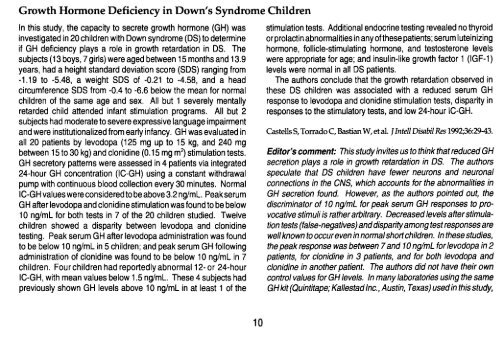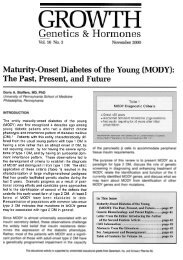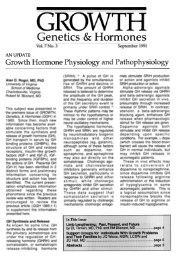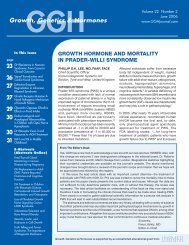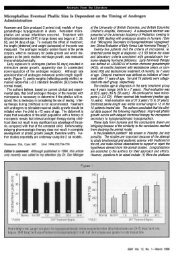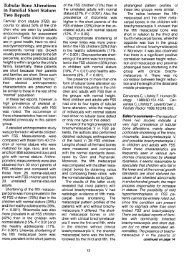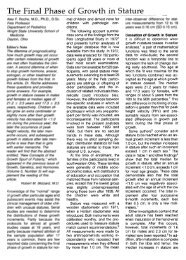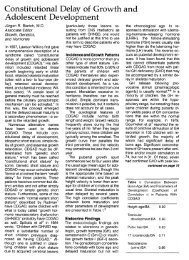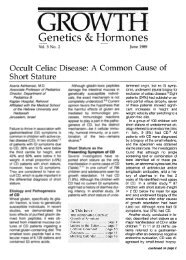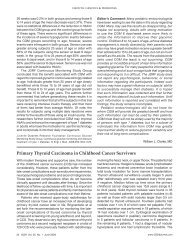Growth Hormone Deficiency in Down's Syndrome ... - GGH Journal
Growth Hormone Deficiency in Down's Syndrome ... - GGH Journal
Growth Hormone Deficiency in Down's Syndrome ... - GGH Journal
You also want an ePaper? Increase the reach of your titles
YUMPU automatically turns print PDFs into web optimized ePapers that Google loves.
<strong>Growth</strong> <strong>Hormone</strong> <strong>Deficiency</strong> <strong>in</strong> <strong>Down's</strong> <strong>Syndrome</strong> Children<br />
In this study, the capacity to secrete growth hormone (GH) was stimulation tests. Additional endocr<strong>in</strong>e test<strong>in</strong>g revealed no thyroid<br />
<strong>in</strong>vestigated<br />
20 children with Down syndrome (OS) to determ<strong>in</strong>e or prolact<strong>in</strong> abnormalities <strong>in</strong> any of these patients; serum lute<strong>in</strong>iz<strong>in</strong>g<br />
if GH deficiency plays a role <strong>in</strong> growth retardation <strong>in</strong> OS. The hormone, follicle-stimulat<strong>in</strong>g hormone, and testosterone levels<br />
subjects (13 boys, 7 girls) were aged between 15 months and 13.9 were appropriate for age; and <strong>in</strong>sul<strong>in</strong>-like growth factor 1 (IGF-1)<br />
years, had a height standard deviation score (SOS) rang<strong>in</strong>g from levels were normal <strong>in</strong> all OS patients.<br />
-1.19 to -5.48, a weight SOS of -0.21 to -4.58, and a head The authors conclude that the growth retardation observed <strong>in</strong><br />
circumference SOS from -0.4 to -6.6 below the mean for normal these OS children was associated with a reduced serum GH<br />
children of the same age and sex. All but 1 severely mentally response to levodopa and clonid<strong>in</strong>e stimulation tests, disparity <strong>in</strong><br />
retarded child attended <strong>in</strong>fant stimulation programs. All but 2 responses to the stimulatory tests, and low 24-hour IG-GH.<br />
subjects had moderate to severe expressive language impairment<br />
and were <strong>in</strong>stitutionalized from early <strong>in</strong>fancy. GH was evaluated <strong>in</strong> Caste1lsS, TorradoC, Bastian W, et ill. J Intell Disabil Res 1992;36:29-4<br />
all 20 patients by levodopa (125 mg up to 15 kg, and 240 mg<br />
between 15 to 30 kg) and clonid<strong>in</strong>e (0.15 mg m2) stimulation tests. Editor's comment: This study <strong>in</strong>vites us to th<strong>in</strong>k that reduced GH<br />
GH secretory patterns were assessed <strong>in</strong> 4 patients via <strong>in</strong>tegrated secretion plays a role <strong>in</strong> growth retardation <strong>in</strong> OS. The authors<br />
24-hour GH concentration (IG-GH) us<strong>in</strong>g a constant withdrawal speculate that OS children have fewer neurons and neuronal<br />
pump with cont<strong>in</strong>uous blood collection every 30 m<strong>in</strong>utes. Normal connections <strong>in</strong> the CNS, which accounts for the abnormalities <strong>in</strong><br />
IG-GH values were considered to be above 3.2 ng/mL. Peak serum GH secretion found. However, as the authors po<strong>in</strong>ted out, the<br />
GH after levodopa and clonid<strong>in</strong>e stimulation was found to be below discrim<strong>in</strong>ator of 10 ngimL for peak serum GH responses to pro-<br />
10 ng/mL for both tests <strong>in</strong> 7 of the 20 children studied. Twelve vocative stimuli is rather arbitrary. Decreased levels after stimulachildren<br />
showed a disparity between levodopa and clonid<strong>in</strong>e tion tests (false-negatives) and disparity among test responses are<br />
test<strong>in</strong>g. Peak serum GH after levodopa adm<strong>in</strong>istration was found we/l known to occur even <strong>in</strong> normal short children. In these studies,<br />
to be below 10 ng/mL <strong>in</strong> 5 children; and peak serum GH follow<strong>in</strong>g the peak response was between 7and 10ngimL forlevodopa <strong>in</strong>2<br />
adm<strong>in</strong>istration of clonid<strong>in</strong>e was found to be below 10 ng/mL <strong>in</strong> 7 patients, for clonid<strong>in</strong>e <strong>in</strong> 3 patients, and for both levodopa and<br />
children. Fourchildren had reportedly abnormal 12- or 24-hour clonid<strong>in</strong>e <strong>in</strong> another patient. The authors did not have their own<br />
IG-GH, with mean values below 1.5 ng/mL. These 4 subjects had control values forGH levels. In many laboratories us<strong>in</strong>g the same .<br />
previously shown GH levels above 10 ng/mL <strong>in</strong> at least 1 of the GHkit(Qu<strong>in</strong>titape;Ka/lestadlnc., Aust<strong>in</strong>, Texas) used <strong>in</strong> this study, ~<br />
10
values between 7 to 10 ngimL could be considered adequate and<br />
would rule out GH deficiency. Moreover, some IC-GH measurements<br />
were made with the Hybritech Tandem kit, which records<br />
lower GH levels than many other assays. F<strong>in</strong>ally, all of these OS<br />
patients had normallGF-1levels for age. Therefore, the patients<br />
did not meet biochemical criteria for classic GH deficiency to<br />
account for growth failure. Unfortunately, only 4 of the patients<br />
who had appropriate responses to at least 1 pharmacologic stimuli<br />
had IC-GH measured, all 4 be<strong>in</strong>g abnormal. There were no such<br />
measurements made <strong>in</strong> the other 16 patients described <strong>in</strong> this<br />
report. Thus, no conclusion should be derived from these very<br />
few cases that the etiology of growth failure <strong>in</strong> OS patients results<br />
from <strong>in</strong>adequate spontaneous GH secretion.<br />
A major pitfall of the study is the fact that obesity was not<br />
considered <strong>in</strong> the equation. Most of the OS patients were obese,<br />
as evidenced by the weight and height data; the majority of them<br />
were overweight for height. S<strong>in</strong>ce obesity is known to cause<br />
hyporesponsiveness of GH secretion to provocative stimuli and to<br />
reduce IC-GH, it is very possible that these obese OS patients<br />
could have responded normally after prim<strong>in</strong>g with pyridostigm<strong>in</strong>e,<br />
as has been demonstrated <strong>in</strong> obese normal children. 1 Elsewhere<br />
these authors reported data that showed benefits of GH therapy <strong>in</strong><br />
OS patients.2 (This <strong>in</strong>formation was reviewed previously <strong>in</strong> <strong>GGH</strong>.3)<br />
Caution must be exercised <strong>in</strong> obta<strong>in</strong><strong>in</strong>g <strong>in</strong>complete data and<br />
extrapolat<strong>in</strong>g results of GH test<strong>in</strong>g to establish the diagnosis of GH<br />
alterations <strong>in</strong> OS to justify treatment with GH. Other genetic<br />
mechanisms that relate directly or <strong>in</strong>directly to gene abnormalities<br />
of chromosome 21 may be most important <strong>in</strong> determ<strong>in</strong><strong>in</strong>g height <strong>in</strong><br />
OS patients.<br />
Fima Lifshitz, MD<br />
1. CordidF,DieguezC,CasanuevaFF. Effect of central chol<strong>in</strong>ergic<br />
neutrotransmission enhancement by pyridostigm<strong>in</strong>e on the<br />
growth hormone secretion elicited by clonid<strong>in</strong>e, arg<strong>in</strong><strong>in</strong>e, or<br />
hypoglycemia <strong>in</strong> normal and obese subjects. JCEM 1990;7(5):<br />
1361-1370.<br />
2. Torrado C, Vastian W, Wisniewski, et al. Treatment of children<br />
with Down syndrome and growth retardation with recomb<strong>in</strong>ant<br />
human growth hormone. J Pediatr 1991;119:478-483.<br />
3. Lifshitz F. <strong>Growth</strong>, Genetics, and <strong>Hormone</strong>s 1991;8(1):15.


